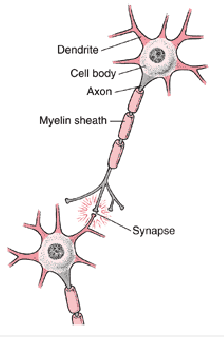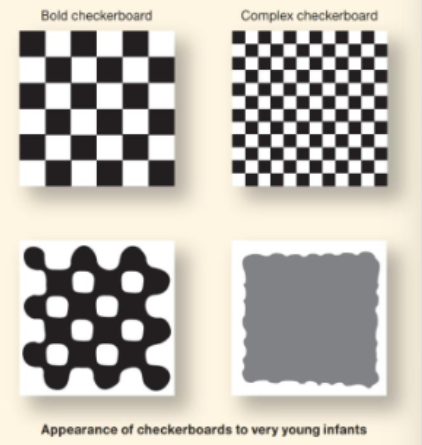CHAPTER 5- PHYSICAL DEVELOPMENT IN INFANCY AND TODDLERHOOD- 1
1/24
There's no tags or description
Looks like no tags are added yet.
Name | Mastery | Learn | Test | Matching | Spaced |
|---|
No study sessions yet.
25 Terms
Physical Development: What are the two growth patterns?
• Cephalocaudal Trend-
• Proximodistal Trend-
Cephalocaudal Trend?
head develops more rapidly at first; rest of the body catches up later
Proximodistal Trend
center of the body develops first, followed by limb
Brain Development involve what?
• Neurons
• Synapses allow for transmission of
neurotransmitters

Synaptic Pruning- explains why we lose neurons we are older
stimulated neurons become strengthened; unstimulated neurons lose synapses
Glial Cells
support neurons; create myelin
Cerebral Cortex-
outer layer of brain
• 85% of brain’s weight; contains greatest number of neurons and synapses
Prefrontal Cortex?
responsible for thought, impulse control, planning, problem-solving, reasoning,
etc.
Lateralization of Cortex
• Left hemisphere responsible for verbal tasks (speech, written language)
• Right hemisphere responsible for spatial tasks (recognizing shapes, judging distance)
• May be reversed or less distinguishable in left-handed people
Brain Plasticity
• Areas of brain not yet specialized to specific function
• High capacity for change and learning
Experience-Expectant Brain Growth
Growth in response to ordinary experiences
• Exploring environment, hearing language/sound
Experience-Dependent Brain Growth
• Growth and refinement in response to specific learning experiences
• Varies across cultures
NFLUENCES ON PHYSICAL GROWTH
• Heredity - predict how big you are as a baby or adult
• Nutrition
Marasmus- condition caused by diet low
in most or all nutrients (baby is not given enough food)
Kwashiorkor- condition caused by diet
low in protein (enough calories, not enough protein)
Swollen abdomen and feet, hair
loss, listlessness
• Sleep - especially adult
• Emotional Care:
Growth Faltering - babies won’t grow if they are not nurtured good.
LEARNING CAPABILITIES
Classical Conditioning
• Reflexes help infants learn about the environment through
conditioning
• Operant Conditioning
• Infant behavior is encouraged or discouraged through
reinforcement and punishment
• Habituation- gradual reduction of response to repeated
stimulation
• Recovery- new stimulus causes high level of response
Motot development?
• Gross-Motor Development
• e.g. sitting, crawling, walking
• Fine-Motor Development
• e.g. grasping, drawing
• Dynamic Systems Theory
• Motor development involves increasingly complex system of actions
Vision?
Visual Acuity
Depth Perception
Depth Cues
Motion - idea if somethingis close or farther away
Binocular Depth Cues - need two to see accurately
Pictorial depth cues - more clear the closer they are
Pattern Perception
Contrast sensitivity → low, they won’t be able to disgush between little difference in color and patterns.

Face Perception
They have the capacity to see a face and prefer to look at that
Object Perception
Size constancy
Shape constancy
What is the intermodal Perception? What does it involve?
Combining information from all senses to perceive things as an intergrated whole
Amodal Sensory Properties
Differentriation theory
Affordances
Amodal Sensory Properties
Amodal properties are especially important in early development as infants use them to integrate sensory information and build a coherent understanding of their environment. For example, when a baby sees and hears a bouncing ball, the synchronized movement and sound provide amodal cues that help them recognize the ball as a single object.
Differentiation Theory?
This theory, proposed by Eleanor Gibson, suggests that infants actively explore their environments to detect and differentiate information. Through repeated experiences, they learn to notice invariant features — properties that remain constant across different contexts.
For example, a baby might learn to recognize their mother's face by focusing on consistent features like her facial shape and voice, despite changes in lighting or angles. Essentially, infants become better at distinguishing between objects, sounds, and events as they gather more sensory input.
Affordances?
Affordances refer to the possibilities for action that an environment or object provides. The concept, introduced by psychologist James Gibson, means that objects and surfaces offer opportunities for interaction depending on their properties and the abilities of the individual.
For example, a chair affords sitting, and a ball affords rolling or throwing. Infants learn affordances through exploration, such as realizing that a small toy can be grasped, while a large one cannot. Affordances are dynamic and can change based on the child's development and motor skills.